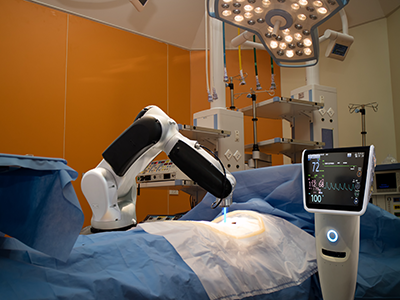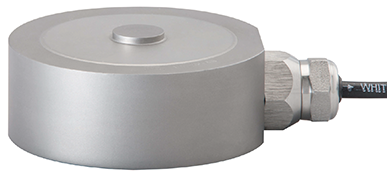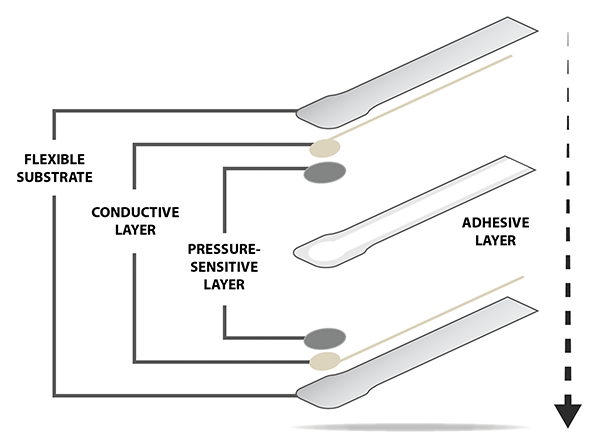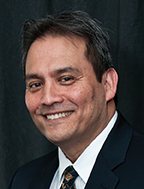 How Ultra-thin Force-Sensitive Resistors Help Address Design Demands for Smart Devices
How Ultra-thin Force-Sensitive Resistors Help Address Design Demands for Smart Devices
The medical device market in the United States is a $60 billion industry and continues to grow at a significant rate. In general, the primary target demographic for the medical device market is not the patients themselves but, rather, healthcare providers who are seeking new and innovative medical devices to improve basic procedural outcomes and patient quality of life. However, in recent years, there has been a noticeable shift in the demand for medical devices that patients can use to treat themselves.
In the past, physicians relied mostly on simple tools and their own knowledge and understanding to best diagnose and treat their patients. During these times, resources were scarce, and the variety of medical devices available to doctors today simply did not exist. However, the world of technology is transforming modern medicine, with the introduction of new and advance medical devices that produce quantifiable data that can significantly improve diagnostic accuracy.
The Importance of Quantifiable Data
Although there have been many significant advancements in the field of medicine in past decades, some medical examinations and diagnoses are still based solely on subjective interpretations and the studied knowledge of the physician. As the medical field continues to evolve, so does the need for a more systemic approach to treating patients efficiently and effectively. Engineers, alongside physicians, have learned that technology can help mimic the actions of doctors while also measuring the specific assessment variables.
In the case of physical therapy, for example, hands-on treatments involve skilled hand movements applied by a therapist to improve the mobility and function of the targeted muscles and tissues must be carefully targeted to a specific location and applied with the appropriate speed and pressure. Yet, research has shown that the amount of force applied by practitioners can vary by as much as 500% and reach potentially dangerous levels. Clearly, the ability to obtain sufficient diagnostic data and deliver needed therapy without harming patients is critical (Jacuinde, G. & Tuttle, N).
In recent years, medical researchers and therapists have sought devices that provide minimal interference with their techniques while also ensuring the proper amount of applied force to a patient. Design engineers were able to construct a glove incorporating small, thin force sensors, simple wiring, and custom software that can directly measure the force applied by the therapist to the patient. Sensors in the glove relay a signal that customized software interprets and converts into a force value. The resulting force reading is displayed as both an instantaneous value and time series graph, enabling the therapist to more carefully calibrate their treatment.
Such advance medical devices enable physicians and healthcare workers to produce quantifiable data that leads to more supportive diagnosis and better data-drive treatments, thereby contributing to an overall improvement in patient quality of life.
Force Sensing Technologies
When it comes to designing a new medical device or tool, design engineers focus primarily on the most efficient, cost effective components that can be integrated into their medical device design. Whether using the tool for a diagnostic, therapeutic or surgical purpose, the engineer must consider a variety of factors when constructing a new device. These factors include accuracy, size, cost and, most important to the medical world, safety and consistency. Healthcare providers are looking for reliable tools with high accuracy, so design engineers must develop products that meet those requirements within the limits of the available technology.
One of the most important elements of a medical device is the feedback it provides the person using the tool, whether it is a primary care physician, a surgeon or a patient. The device design must support a flow of communication between the patient’s body, the tool used, and the healthcare provider reading and analyzing the output. In addressing these requirements, force feedback has become a key element in the design of new medical devices. The human body is a sensitive object, so the amount of force applied during treatment is a critical consideration.


There are a few ways that force can be measured but, depending on specific application, some force sensing technologies prove to be more ideal than others. Load cells, strain gauges, and piezo-resistive elements are different types of devices used to measure force, but the most widely-known device used by researchers and engineers to measure force is the load cell. Load cells can use a variety of technologies, but they are bulky in size, making them difficult to integrate into an application where light weight and small size are priorities.
To obtain force measurements, engineers also frequently use strain gauges. Strain gauges are smaller than load cells, but produce measurements that are a result of indirect force measurement drawn by correlating the strain of an assembly with a load. Both load cells and strain gauges also require expensive electronics to obtain accurate force readings.
In recent years, a different approach to force sensing technology has become commercially available. The generic term for this device is the force-sensitive resistor (FSR). Typically built on a flexible circuit material, these sensors are sensitive to touch. Further, they are thin and lightweight, making them ideal for integrating into a variety of products, including medical devices.
One example of an FSR is shown in Figure 3. It consists of piezo-resistive material sandwiched between two pieces of flexible polyester. The polyester has printed silver conductors on each inner half. These conductive traces form electrical connections to external circuits. These force sensors are resistors that vary linearly in terms of conductance versus force under an applied load.

The Application of Force Sensors in Medical Devices
Today, a broad range of medical device applications utilize force sensors. They can play a variety of different roles in the lives of both healthcare providers and patients. Medical devices tools used to monitor and control a patient’s key metrics (for example, blood pressure or drug delivery) can be designed with integrated force sensors that measure the forces applied to a specific area, which can then be relayed via selected output or electronics.
The following sections illustrate some specific examples of medical devices that incorporate thin and flexible force sensors to enhance device functionality and produce quantifiable data.
Surgical Devices
A key contributing factor to a successful surgery is sensory feedback. The interaction between a surgeon, their tools and a patient’s body can be a matter of life and death. In recent years, with the help of modern surgical tools, surgical procedures have become increasingly less invasive. With the introduction of laparoscopic surgery, the use of small incisions to the body and a camera at the end of a thin tube to capture visuals of a specific organ, minimally invasive surgery has become the desired standard.
Small medical devices used for minimally invasive surgeries, such as catheters and endoscopes, depend on measurements relayed by force sensors integrated in their design. For example, cardiac catheters used to diagnose cardiac disease contain sensors that measure certain pressures within the heart. These devices can provide surgeons with vital information before performing a surgery. Endoscopes utilize pressure sensors for careful navigation through the body area to be examined, ultimately to help detect polyps or cancers, as well as an organ’s overall health (Guziak, R., & Appel, L). The thin, miniature nature of force pressure sensors allows engineers to design medical devices that enhance surgical environments and help improve patient survival rates.

Due to advances in electronics and technology, robotic surgery has become increasingly popular. Surgeons no longer have to operate directly on a patient, but can instead control a robotic device to carry out the procedure. Robotic surgery has benefits for both the surgeon and the patient. For the surgeon, robotic devices can display 3D visualization for enhanced viewing of the operative area and improve the control, precision, and range of motion of smaller instruments. In terms of the patient, a more precise and controlled surgery results in less invasive surgery due to smaller incisions, shorter hospitalization periods and faster recovery times (Florida Hospital Global Robotics Institute).
However, while robotic surgery may seem like the future of the medical industry, it still has its drawbacks. A significant disadvantage to robotic surgery is the lack of haptic technology and the inability to provide force feedback. This lack of feedback that is attainable by a human makes it more difficult for a robotic device to perform a successful surgery. Today, surgeons using the robotic controls must depend on tactile cues and visual confirmation to direct the robotic device.
Another example of a sensor-based robotic device relies on pressure sensors and force feedback to perform hip and knee procedures. Before a procedure, the robot device is calibrated based on CT scan results performed in preparation for operation. Then, during the procedure, should the surgeon apply too much pressure to the specific section of the hip or knee, the robotic controls actively push back against the operator, cueing them to ease up on the load (Sofge, Erik).
The rise of popularity in robotic surgery has also sparked a growth in the market for haptic medical devices. Design engineers are working toward integrating tactile features into common medical tools to create a more engaging and efficient surgical environment. For example, surgical grippers are a tool frequently used during invasive operations, since they provide surgeons with access to parts of the body that are not otherwise easily accessible. However, most grippers used today do not relay any type of sensory element to the operator, making it difficult for the surgeon to recognize how much pressure or force they are applying to the operative area.
Today, medical device engineers are working to design grippers that include small, thin-force sensors to help detect force measurements throughout an operation. These types of sensors are flexible and easy to integrate into various designs while also producing consistent data. By placing force sensors at the gripping area of the device, simple wiring and electronic feedback can alert surgeons when a certain area is receiving too much pressure, thereby helping to avoid a break or pull.
Assistive Living Devices
Force sensing technology is also an important feature in medical devices used outside a hospital setting. After a diagnosis or treatment, a patient often returns home with the assistance of medication or some form of medical device. An assistive living device helps monitor the patient’s health and the progress of treatment. Because the patient is usually required to keep these types of medical devices on or near their bodies, it is important that the device be small, lightweight and noninvasive. Small, thin, force sensors provide a simple solution designed to easily receive accessible data in devices such as these.

For example, when equipped with small force sensors, wearable, drug-delivery infusion pumps can detect potentially life-threatening blockages. When a blockage occurs in the pump, the tubing within the pump expands and a customized force sensor located where the tubing meets the housing can detect this expansion. The sensor then triggers an alarm to alert the user of a detected blockage, so that they can take the steps necessary to correct the problem.
Force sensors can be integrated into medical devices used in a variety of settings such as hospitals, hospices, and home-care. New, medical devices with integrated force sensors are providing physicians with continuous, real-time access to vital patient health information. Sensor-based monitoring systems are also becoming increasingly popular in a range of medical devices generally used in long-term geriatric care. For example, force sensors integrated into apparel worn by elderly patients, such as shoe insoles, or into furniture such as a bed frame, can provide insight into a patient’s daily activity or lack thereof, allowing more attentive care or treatment.
Another type of assistive living device is one whose main purpose is to communicate exclusively with the patient’s body. An example would be a device that senses when a patient’s foot is on or off the ground and which can make adjustments in the foot to help minimize the risk of falling while walking. A force sensor within the shoe relays wireless signals to a leg cuff, which then produces electrical stimulation to specific leg muscles. This stimulation of nerves and muscles signals the foot to lift off the ground and helps the user walk more naturally. This type of assistive device can provide patients with a sense of control that may be otherwise missing from their daily life.
Medical Training Devices
Many years of study and training are required in order to become a medical professional. Field experience is a key component for medical students in order to increase their skill sets and gain significant knowledge of how to treat medical conditions. As such, training medical devices have become increasingly important in establishing standards among medical professionals and trainees.
For example, cardiopulmonary resuscitation (CPR) is a lifesaving technique performed by millions of people each year. However, a significant portion of trainees lack the ability to successfully perform CPR in a life-threatening situation, placing patients at risk. Self-guided and classroom-based CPR training programs now use sensor-based, interactive CPR manikins, which provide important features such as technique assessment and vital sign simulations. Manikins with integrated force sensors can accurately locate the pressure points of applied compressions, helping to ensure proper hand placement and providing students with quantifiable feedback on their CPR technique.

Another example of a medical training device that integrates ultra-thin force sensors is a device used to detect palpable breast cancers, which are frequently undetected by imaging. These devices incorporate tactually accurate breast models instrumented with sensors. These small tactile sensors relay over 1,000 levels of clinical examination pressure within each square centimeter of the device via a digital signal processor. Indeed, one such device is now recognized as the medical and scientific standard for clinical breast examination efficiency.
Conclusion
Force-sensing technologies are now an integral component in a variety of medical devices. The capability of the device to maintain proper communication with its user is a desired function that has become standard. Sensors are a thin, easy to integrate and customizable design option. If designed into a device, these tactile sensors help eliminate guesswork for the user by producing tangible and quantifiable data. The data produced by sensors and electronics allows healthcare providers with greater insight into their patient’s health and recovery process, leading to an increased understanding of a patient’s condition and more effective treatments.
The data provided by force sensors not only improves patient outcomes, but also provides a standard of consistency, which is a common goal among healthcare practitioners. Although each patient’s case is different, consistency among treatments and therapies is critical. When a patient is under evaluation, being able to study quantifiable data and base treatment on concrete numbers and science is the ideal. Thin, tactile sensors are durable, dependable and cost-effective solution for design engineers seeking to create medical devices that are both intelligent and practical to manufacture.
References
- Jacuinde, G. & Tuttle, N., “Design and Construction of a Novel Low-Cost Device to Provide Feedback on Manually Applied Forces,” Journal of Orthopaedic & Sports Physical Therapy, 41(3), March 2011.
- Guziak, R., & Appel, L., “The Role of Pressure Sensors in Medical Devices,” ECN, Oct 5, 2009.
- “How the L300 Foot Drop System Works,” Bioness: Live On, Bioness Inc., 1 May 2013,
- http://www.bioness.com/L300_for_Foot_Drop/How_Does_It_Work.php.
- Neuman, M.R.; Baura, G.D.; Meldrum, S.; Soykan, O.; Valentinuzzi, M.E.; Leder, R.S.; Micera, S.; Yuan-Ting Zhang, “Advances in Medical Devices and Medical Electronics,” Proceedings of the IEEE, vol. 100, no. Special Centennial Issue, pp.1537, 1550, May 13, 2012.
- “Robotic Surgery Benefits,” Florida Hospital: Global Robotics Institute, Florida Hospital, April 15, 2013.
- Sofge, Erik, “The Sensitive Robot: How Haptic Technology is Closing the Mechanical Gap,” Connections: Finding Opportunity in the Global Economy, T. Rowe Price, March 2013.
 Mark Lowe, MBA & MSME, is Vice-President of the FlexiForce™ Sensors Division with Tekscan, Inc., and has more than 25 years of experience spanning research, mechanical engineering, and management positions. Mark joined Tekscan in 1997 and since then has held a number of roles, including Applications and Test Group Manager and Director of Engineering.
Mark Lowe, MBA & MSME, is Vice-President of the FlexiForce™ Sensors Division with Tekscan, Inc., and has more than 25 years of experience spanning research, mechanical engineering, and management positions. Mark joined Tekscan in 1997 and since then has held a number of roles, including Applications and Test Group Manager and Director of Engineering.
Mark is primarily focused on driving Tekscan’s OEM embedded sensor business. He also oversees the company’s Sensor Design and Applications Engineering groups and is closely involved in developing and incorporating new technologies.
Mark graduated Magna cum laude from Northeastern University with a Master of Business Administration, High Technology degree, and also holds an MS in Mechanical Engineering from Northeastern. He can be reached at mlowe@tekscan.com.
